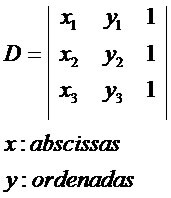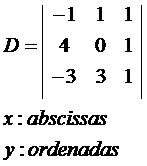We can determine the area of a triangular region using expressions related to Plane Geometry. In situations involving the position coordinates of the vertices of a triangle, calculations are performed from according to the determinant of a square matrix, formed by the coordinate values of the points of positioning. The constructed matrix must contain in one of its columns the values of the abscissa and in another, the values of the ordinates of the points, a third column will be completed with values equal to 1.

The area of the triangle will be determined by half the value of the determinant. Look:

The vertices of a triangle have the following location coordinates: A(–1, 1), B(4,0) and C(–3, 3). Let's determine the area of this triangular region using the principles of the determinant of a matrix.

Applying Sarrus

main diagonal
(–1) * 0 * 1 = 0
1 * 1 * (–3) = –3
1 * 4 * 3 = 12
Sum: 0 - 3 + 12 = 9
secondary diagonal
1 * 0 * (–3) = 0
(–1) * 1 * (3) = – 3
1 * 4 * 1 = 4
Sum: 0 - 3 + 4 = 1
D = (Sum of the product of the elements of the main diagonal) - (Sum of the product of the elements of the secondary diagonal)
D = 9 - 1
D = 8
A = |D| / two
A = 8 / 2
A = 4
The area of the triangular region with the vertices located at points A(–1, 1), B(4,0) and C(–3, 3) corresponds to 4 area units.
by Mark Noah
Graduated in Mathematics
Brazil School Team
Analytical Geometry - Math - Brazil School
Source: Brazil School - https://brasilescola.uol.com.br/matematica/Area-regiao-triangular-relacao-as-coordenadas-dos-.htm
